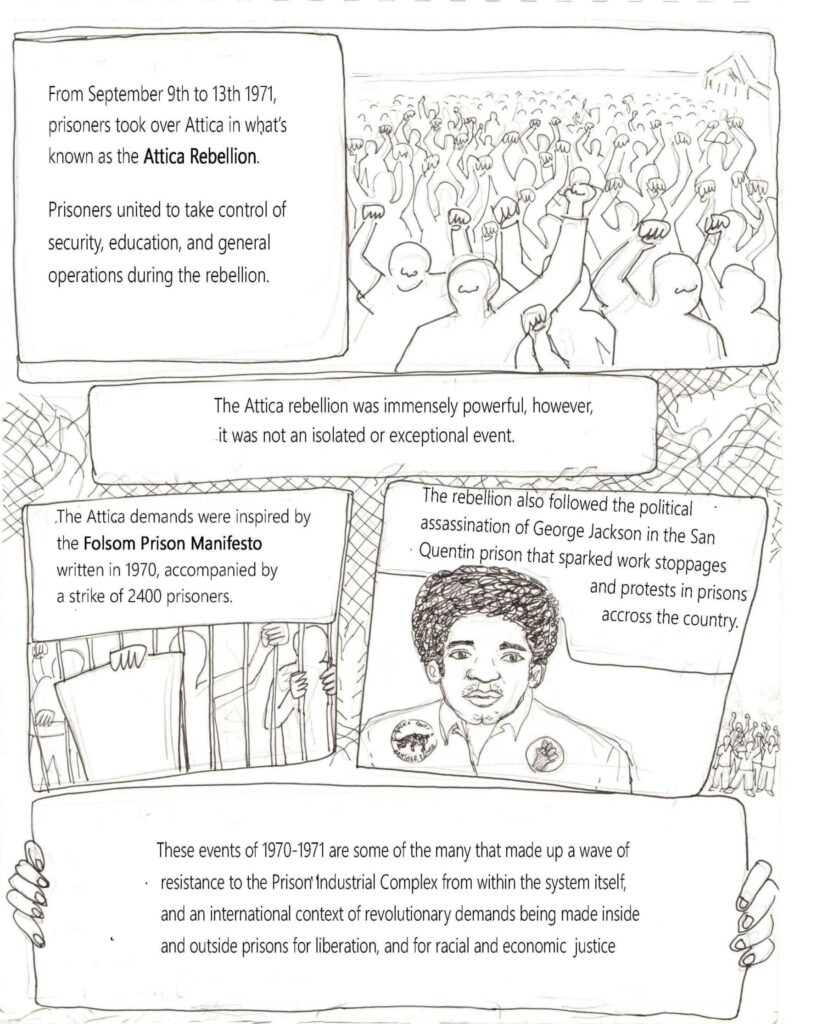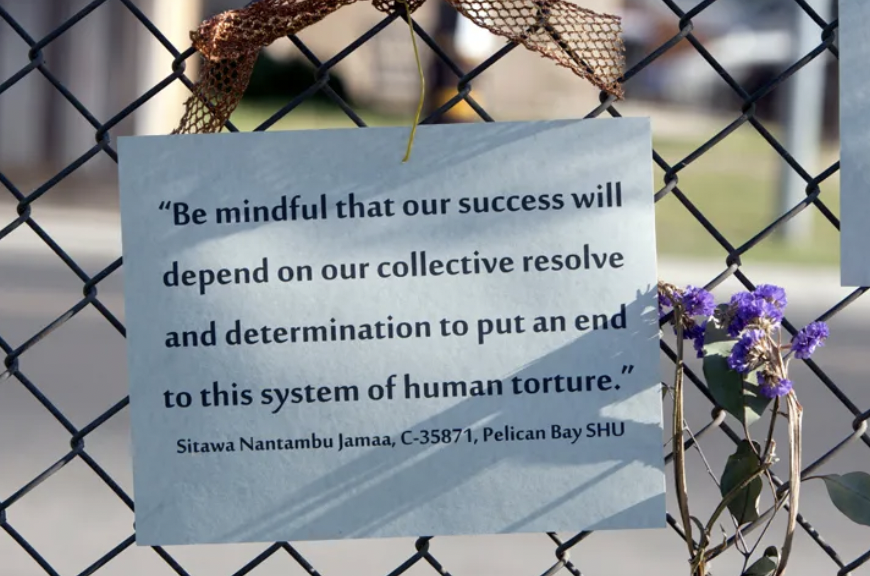This week this year marks the 52nd anniversary of the Attica Rebellion—when from September 9-13, 1971, about 1,300 prisoners rose up in resistance against horrible prison conditions. In solidarity with the assassination of revolutionary prisoner movement leader and intellectual George Jackson at Soledad prison in CA just three weeks prior, prisoners at Attica took control of the notorious prison in New York state for five days until they were met with brutal violence, assault, and torture. As we commemorate the 52nd anniversary of the Attica rebellion, Critical Resistance (CR) uplifts some movement updates, events, actions and resources in hopes of strengthening outside solidarity for prisoner-led resistance today.
The Attica Rebellion remains a monumental moment in movement and abolitionist history; in many ways it was the pinnacle of the revolutionary prisoner movement. In no way a spontaneous action, the Attica rebellion was a result of years of prisoners organizing, studying together, uniting and forging strong alliances among Black Panther, Young Lord, Black Muslim, and white radical anti-imperialist prisoners—across racial and political lines. As former Critical Resistance (CR) member Liz Samuels points out the Attica rebellion was:
“pivotal for the development of what can be called prison abolitionist praxis. This political approach, at once an analysis and a strategy, held that ‘prison reform’ was not just insufficient, but also counterproductive. It sought instead to remove entirely the system of imprisonment and policing through a revolutionary transformation that would render such institutions unnecessary.”
So too was the inside organizing that made the rebellion—the years of study and political struggle to develop shared political analysis and build a united revolutionary “prisoner-class” state to state through prisoners’ study groups and skill shares, councils, unions, self-improvement and “cultural awareness” groups, newspapers, inside-outside revolutionary organizations, and national networks to fight for prisoners’ political self-determination.
The makings of the Attica rebellion are especially pertinent to today also because the rebellion marked the beginning of the development of what we now call the prison industrial complex (or PIC). It was moving into the 1970s after Attica when the congealing of imprisonment, policing and surveillance into an overlapping set of counter-insurgency interests emerged resulting in the mushrooming of prison populations (the US prison population at the time of Attica was only 200,000, and as the PIC developed through the 1970s into the 1980s and 1990s, the prison population reached its peak of over 2.5 million people in 2009). The strategies of repression and torture used to quell the Attica rebellion and parallel resistance in other prisons nationally have since proliferated across the PIC, expanding its reach and impact while tightening its repressive hold on strategic, successful resistance and revolutionary organizing inside and outside of cages. The norm of living collectively in prison was ended; programs gradually were slashed prison to prison, while extreme isolation through torturous conditions of solitary confinement, divide-and-conquer tactics and the criminalization and punishment of prisoners coming together in groups or any form of collectivity became the standard response to squash prisoner resistance and organizing and maintain power.
While repression breeds resistance, understanding the Attica rebellion as a mark to the onset of the PIC then helps us calculate that strong resistance which threatens the security of a prison or the PIC at large will continue to be met with more, brutal repression. And even our victories and each fight will be countered in force. The current swinging increase in repression inside and outside of cages across the US—from the city of Atlanta’s response to referendum canvassing to stop Cop City, to the banning of gender-affirming care and access for queer, transgender people, and women alongside the targeting of abolitionists in prisons, and attacks on critical race theory and ethnic studies across institutions—is evidence of this.
In California, for instance, just before the anniversary of Attica, the 9th circuit court ruling nullified the historic 2015 Ashker Settlement that ended indeterminate solitary confinement in CA and codified the victories against solitary confinement made by the 30,000+ strong prisoner hunger strikes in 2011 and 2013 that rocked the globe and was started by prisoners in the Pelican Bay Security Housing Unit (SHU) called the Short Corridor Collective. While this decision ended the past six years of legal monitoring of CDCR solitary confinement regulations that resulted in many hunger strikers being released from long-term security housing units into general population (and now could be returned to SHU), it does not erase all the advances of prisoner-led people power that was built, particularly the re-emergence of a unifying “prisoner-class” as was with the Attica Rebellion, and more specifically the historic Agreement to End Hostilities that hunger strike leaders of the Short Corridor Collective created as a strategy for uniting the prisoner class across prison-manufactured racial divisions and is still in place.
As Arturo Castellanos, one of the Short Corridor Collective leaders still inside and a plaintiff of the settlement said in repsonse to the recent court decision:
“The Agreement to End Hostilities isn’t going to change even if this case is over and done. That’s our decision. The court has nothing to do with it. CDCR has nothing to do with it. It was the prisoner-class that decided on the Agreement to End Hostilities, and we are continuing to support it. They are going to continue to try to divide us. We succeeded in a lot of ways in this case.”
Similarly, Sitawa Jamaa of the Short Corridor Collective remarked:
“This is a closed road with all of us in CDCR. We can’t allow CDCR to divide and fragment us. That’s an old song and dance they’ve been doing for years. […] We have to show that we are not divided—we are one, as we started in the beginning. We are one today. We are with that centralized focus going forward in dealing with the many voices of the democratic way and in doing that with ya’lls help, we can be more successful in galvanizing the people. This is our future and future generations of people.”
As CR moves forward in our various anti-imprisonment campaigns and projects, we continue to ground our solidarity with imprisoned people now in memory of the Attica rebellion. Working to dismantle the PIC in all its forms, all of Critical Resistance’s work—from closing prisons to resisting policing—is done through a spirit of solidarity with people locked up inside prisons, jails and detention centers, as the aim of our work is to free all prisoners and demolish cages while dismantling the whole PIC, changing our conditions, relationships and systems of power, and building the life-affirming community, systems and infrastructure we need to live lives worth living. Our work producing The Abolitionist newspaper two times per year remains in the tradition of the Attica rebellion, working to ignite and fortify prisoner-led resistance and strategies for PIC abolition inside and outside of cages. Providing direct communication, organizing and political education support to imprisoned people also through our mail programs and phone lines, CR builds politicized relationships with people inside, with the aim of rebuilding the inside-outside groundwork needed for a winning abolitionist movement with imprisoned people participating in leadership, which the PIC works tirelessly to suppress. We do this work and more in the spirit of the Attica Rebellion.
As George Jackson said:
“The point is…in the face of what we confront, to fight and win. That’s the real objective: not just to make statements, no matter how noble, but to destroy the system that oppresses us. By any means available to us. And to do this, we must be connected, in contact and communication with those in the struggle on the outside.”
Long live the Attica rebellion!
Free them all!
Abolition NOW!
Onward,
– Critical Resistance
Updates, resources, and action alerts linked throughout this newsletter:
- “Improvising on Reality: The Roots of Prison Abolition” by Liz Samuels (article on Attice)
- Agreement to End Hostilities by the Short Corridor Collective (a tool for cross-racial solidarity organizing inside cages and outside in our communities)
- Join CR September 21 for a webinar on reproductive justice & abolition: Our Bodies, Our Freedom – Abolishing the PIC Post-Roe
- Imprisoned people, outside organizers and anti-prison advocates in Kentucky are working to stop the fast-track construction of a new 1,408-bed federal prison in Letcher County, Kentucky. Sign on to opposition letter TODAY HERE!


